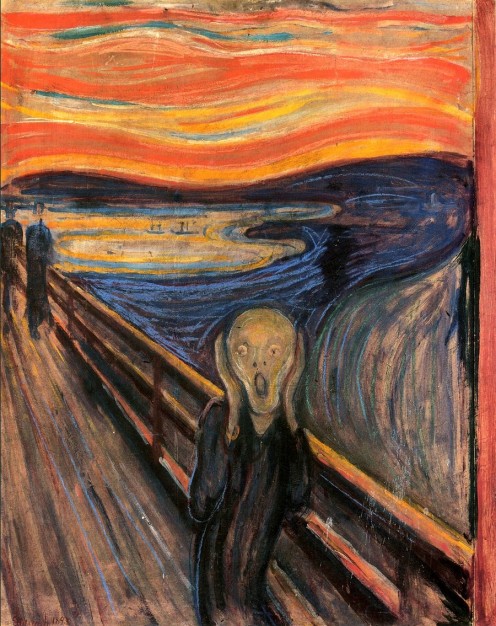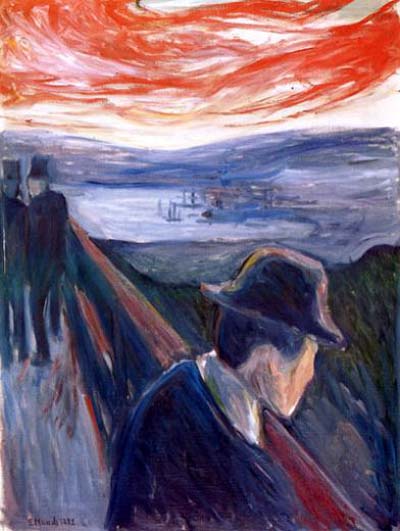 | |||
 | |||

|
"The Scream" (various media 1893-1910) - Edvard Munch - Painting Location: Oslo, Norway 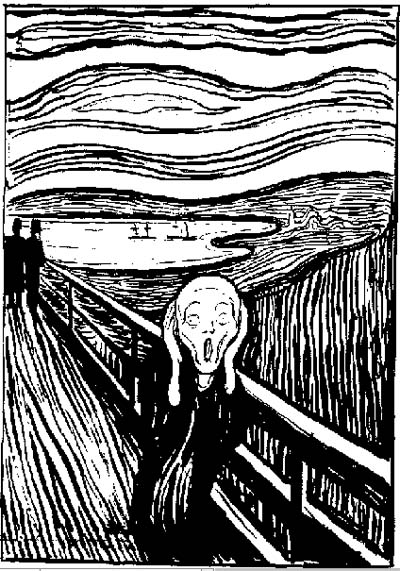
The Scream" - lithograph version from 1895. "The Scream" is one of the world's most recognizable works of art. It depicts a man in a private moment of anguished despair and anxiety, while the other people in the painting, perhaps his friends, seem blissfully unaware of the man's situation. The Norwegian painter Edvard Munch (1863-1944) did several versions of "The Scream," an alter image for himself (more on this later), in oil, pastel,and litohgraph between 1893 and 1910. This my favorite version because the stark contrast of the black-and-white lines mirrors the disconnect between the man's mood and the peaceful surroundings.
The site of the painting is an overlook on the side of a road called "Valhallveien" on a hill above Oslo, Norway. The hill is known as Ekeberg Hill, Ekeberg being a neighborhood of Oslo just south of the city. The winding road up to the park on the top of Ekeberg Hill was a popular place for citizens of Oslo to view the city. The hill and park were also popular places for Oslo artists to paint. Who ya gonna call? Ghostbusters! HOW I FOUND THE LOCATION (Not that I was the first - the Norwegians know it - but it doesn't seem too well-known outside Norway) First, a little background: The Wikipedia entry for "The Scream" pretty well sum's up what I've read of Munch's inspiration: "The original German title given to the work by Munch was Der Schrei der Natur (The Scream of Nature). The Norwegian word shrik is usually translated as scream but is (equivilent to) the English "shriek." Occasionally, the painting has been called The Cry. In a page in his diary headed Nice 22.01.1892, Munch described his inspiration for the image: I was walking along a path with two friends - the sun was setting - suddenly the sky turned blood red - I paused, feeling exhausted, and leaned on the fence - there was blood and tongues of fire above the blue-black fjord and he city - my friends walked on, and I stood there trembling with anxiety - and I sensed an infinite scream passing through nature." In addition, some scientists say there is a natural phenomenon that occasionally turns the sky over Oslo somewhat red, and that, is is thought, what gave Munch a panic attack. Whatever the cause, Munch really captured a feeling that everyone can relate to even if it's just, "Oh, S#*@!, I left the toaster on at home! You know the feeling.
Looking at the image of "The Scream," it always seemed to me that the man screaming was on a long pier or the side of a bridge, both thoughts having to do with water, perhaps because there is a large body of water on which masted ships are sailing behind him. 
So my initial thought was that the location was either a seacoast town in Norway or along a large Norwegian lake, as the sailboats seemed pretty big. Some other visual clues to the location: Besides the two tall-hatted men in the background, who seem oblivious to the situation, in the background you can also see the pointed steeple of a tall building, most likely a church, and to its right, some wavy lines suggestive of some other buildings. So I began my search on Google with the search terms "Munch The Scream location." But other than an occasional "on a road near Oslo" nobody seemed to write about the exact location. Then, I narrowed my search from regular Google to just Google Books, which bypasses random links about Munch and "The Scream" and focuses on those found in books. Eventually I found a book that said that the Munch set the painting on a road leading up a hill in Ekeberg, a neighborhood of Oslo, Norway. (The book was: "The Private Life of a Masterpiece" by Monica Bohn-Duchen.) Well, good enough. So I used Google Maps to go to Oslo, Norway. First I saw that it was an inland city, which countered my impression that the water in the painting might be right next to the sea. All right, I thought, so maybe a lake. Then, when I zoomed in, I saw that the city was, in fact, really on the water and that what looked like the sea in "The Scream" was actually part of fjord, which is described as "a long, narrow inlet of the sea between steep cliffs." Zooming further into Oslo, I could see several of the coves of water that I would later discover were the two coves in the picture. I could also see the Oslo neighborhood of Ekeberg to the south, the one with the hill from which the painting was made. I then searched Google Images to see what clues I could find about the tall church church steeple in the painting. The tallest building in Oslo turned out to be the Oslo Cathedral, which had the same basic shape of the steeple in the background of "The Scream." So I figured that was the tower. I also located the Oslo Cathedral on Google StreetView but, after searching the vicinity, could not find any other really tall buildings that might have been represented by the the squiggly lines to the right of the Cathedral tower in "The Scream." Had the "tall buildings" been to the left of the Cathedral, the squiggly lines might have represented the Royal Palace (see below). Note that Oslo was named Christiania (sometimes with a K) back in the day. Oslo is easier to spell. Thank you, Norway. As I was doing this research, I ran across a close-up photo of a copper plaque for "The Scream." It was on a blog, together with some shots from a mountain looking down into Oslo, so I figured the plaque had something to do with the hill in Ekeberg. "The Scream," to reiterate, is called The Shriek in Norway, and spelled similarly. I also ran across this photo of a road running next to a fjord near Oslo, with a fence that looked very much like that in "The Scream." So I knew I was geting closer, as things were starting to fit together. Now, knowing that in the painting, the 2 coves of water would be to the left and the Cathedral would be to the right, I zoomed in on Ekeberg Hill to see where Munch might have been standing while he looked out and painted the scene, while looking northwest to Oslo. On the side of the hill closest to Oslo was a winding road; so I chose a section of the road closest to Oslo and dragged the little orange Street View Man down to the road. And closer... I "landed" on a highway with Oslo off in the distance. To the left of the city, I could see two coves of water that matched those in the painting. "Pretty Cool. So it's not a lake after all. It's a bay! I said to myself. And in the center of the scene (by blowing the picture up huge), I could also see the Cathedral Steeple. "The PopSpot eagle has landed!" I told myself.
And, looking at the same view, in close up, with better contrast...." Also noticeable in the scene was a metal railing alongside the sidewalk that very much resembled the wooden-looking railing that was in the picture next to the fjord and that I had always thought was the side of a pier. The metal bands must be the modern replacement for the wood. Now, using Google StreetView I "clicked" my way up the highway a bit to see the view of the city from a diferent angle. And... what should I come up upon at the end of the overlook? - the "SHREIK" plaque! It was on a small concrete wall off the side of the road. If I had any doubts that this as the place where the painting was set, they were over now. This was a plaque-certified, offical Norwegian PopSpot already. So I backed up a little to get back where I had been. To refresh your memory: Here's where I was on the mountain road - with an arrow pointing to downtown Oslo. And here's the angle of what you see in back of the man in The Scream. I'll illustrate it two ways: The first makes it easier to see the coves in the background (The picture's not clear enough to make out the Cathedal but it's there in the right place... And the second photo, in true "this-is-the-spot" Popspots overlay style. Voila! Now, as I mentioned, in addition to "The Scream, Munch created a variety of similar themed painting about states of anxiety from this point of view overlooking Oslo during the years between 1893 to 1910. Along with the diferent versions of The Scream, they were part of a series called "The Frieze of Life." Here are some of the others, in chronological order. (I may be missing some.) The Scream - 1893 - oil, tempura, and pastel on cardboard. The National Gallery, Oslo, Norway)
Despair - oil on canvas from 1894
Despair - also 1894 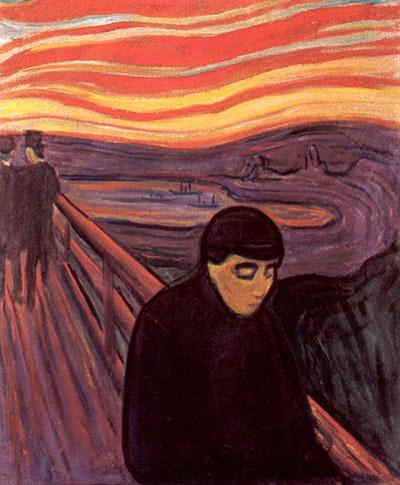
Anxiety - oil on canvas from 1894 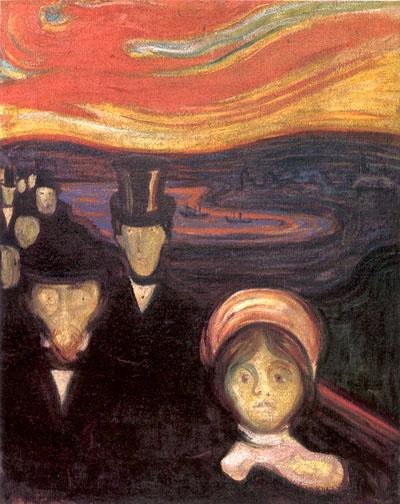
The Scream - an 1895 lithograph 
The Scream - an 1895 lithograph with additional colors - Munch Museum - Oslo 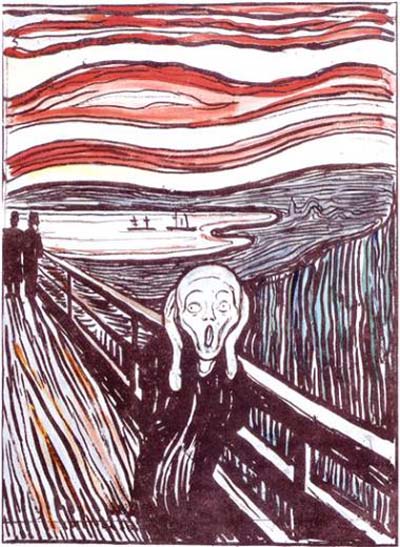
The Scream - oil on canvas from 1895 - owned by Norwegian businessman Petter Olsen whose father was a friend of Munch; to be sold at auction May 2, 2012. The only version with a figure in the background leaning over the railing. 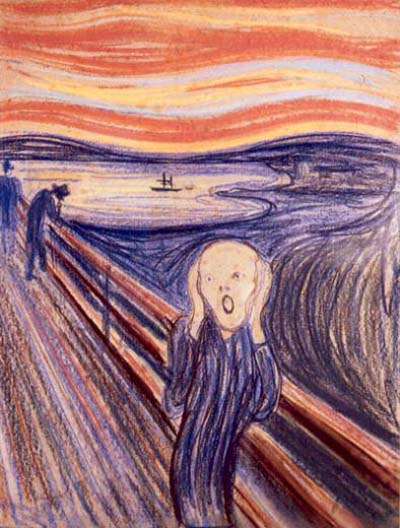
Anxiety - woodcut from 1896 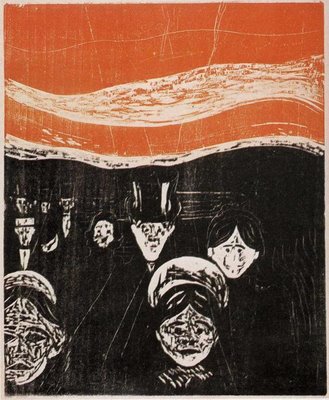
Anxiety - lithograph from 1896 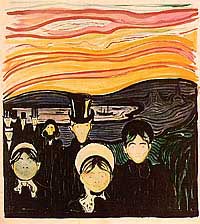
The Scream - mixed-media technique on unprimed cardboard from 1910 - The Munch Museum, Norway 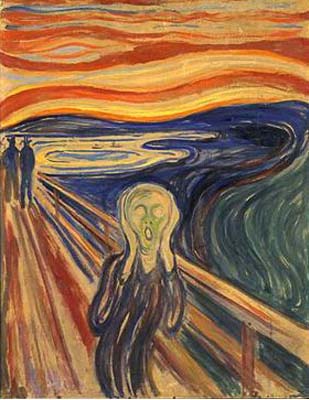
While The Scream wasn't painted on a bridge, Munch actually did so some paintings on bridges like this one called, "The Girls on the Bridge" from 1901. You can see that his roadsides look like his bridges. 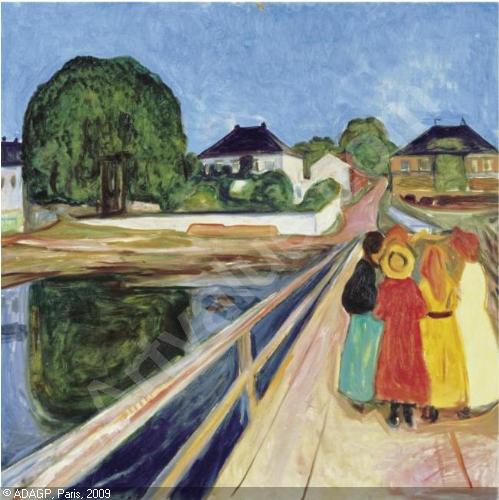
When Munch died in 1944, he left most of his work to the city of Oslo. In turn, they built the Munch Museum, so for further study, see their website. And also visit the website of the National Gallery of Norway which has several Munch paintings. Munch was part of the Expresionist movement in art that developed as a response to the more "tranquil" world of the Impressionists. Here is what Munch looked like in a self portrait from 1895. He actually does resemble the man in The Scream a bit. 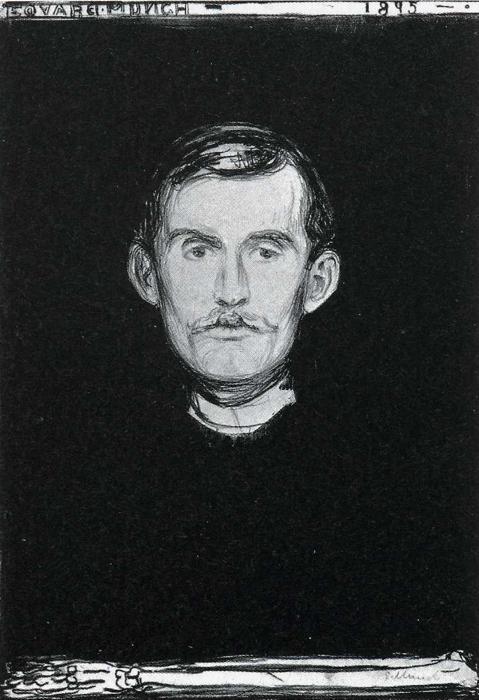
The Self-portrait above is actually called, "Self-portrait with skeleton arm" and there is a skeleton arm on the bottom. A British Museum commentary refers to the bones as "a reminder of death.") "The Scream" has been parodied thousands of time by substituting iconic figures like Homer Simpson or the Pillsbury Dough Boy or politicians like Dan Quayle (George Bush Sr.'s vice president) for the little man. The movie poster for "Home Alone" seems to have been inspired by the painting. And it also seems to be the inspiration for the mask in the movie series "The Scream." Some parodies are very funny and to see hundreds of them at once, go to Google Images and type "The Scream Parody" into the searchbox. And I'll leave you with daughter, Alice's Halloween reenactment of "The Scream." She's probably thinking, "Oh, my God I can't believe he's going to use THIS picture!" AAAaaaaaaa! 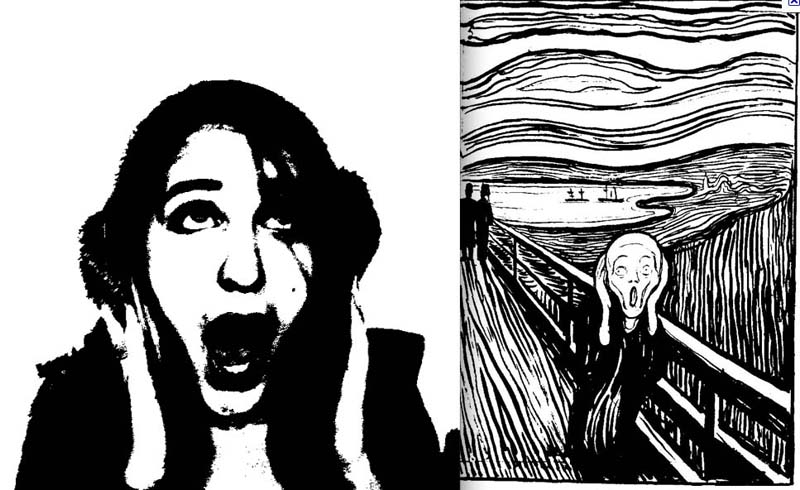
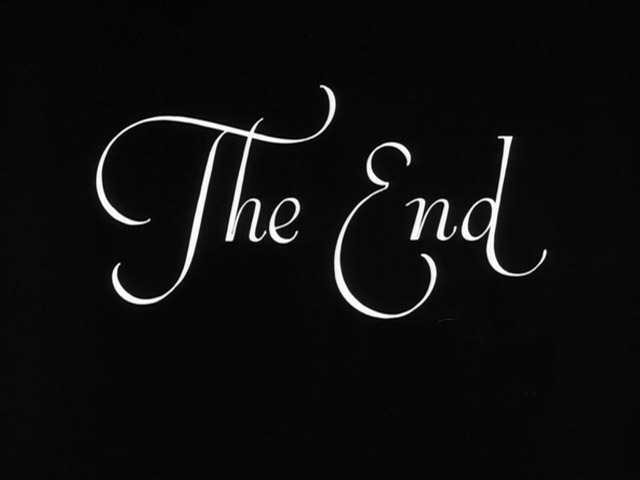
|
||

